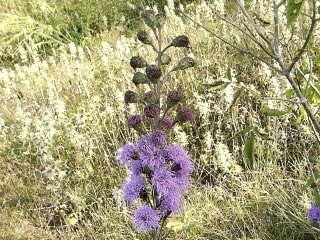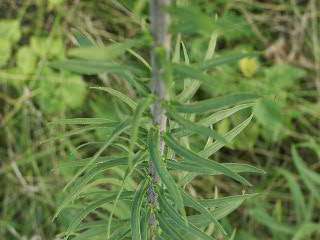Rickert Nature Preserve
Liatris_Ligulistylis
Meadow Blazing Star
A striking addition to the late spring or early summer flora of the Dakota grasslands is purple locoweed. This is a genuine prairie denizen, being found in the band of grasslands that stretches from Manitoba and Saskatchewan to Oklahoma and Texas.
The plant is exceptionally showy because, on robust plants, the long stems bear up to twenty-five bright bluish or purple flowers about three-fourths of an inch long. A single root crown may produce a dozen stems over a foot long. About two dozen hairy leaflets are arranged along a midrib to form erect leaves about six inches long. The heavy, alfalfa-like taproot penetrates deep underground. At maturity the silvery-hairy legumes (pods) are about as long as the flowers.
Purple locoweed has been shown to produce symptoms characteristic of loco poisoning when fed to penned livestock but toxicity does not seem to be a problem in the wild. This plant can usually be found even in heavily grazed dry pastures which indicates it is avoided by livestock.
Purple locoweed is a member of the huge bean family (Fabaceae). Fab means "bean" in Latin. The generic name Oxytropis was compounded from the Greek oxys, "sharp," and tropis, "keel," in reference to the pointed tip on the two lower flower petals. The German botanist Frederick Pursh dedicated this species to the English botanist Aylmer Lambert from whose cultivated plants he described it in 1814.
Purple locoweed (Oxytropis lambertii) is found in the southern parts of Manitoba and Saskatchewan. This species can cause locoism, a chronic disease that results after long-term grazing. The plant contains swainsonine, an alkaloid, which results in cellular dysfunction through a long biological process. Affected animals show nervous system impairment, with symptoms such as dullness and excitement, as well as immune system impairment. Abortion and congenital birth deformities may occur. Animals affected include cattle, horses, and sheep. Animals may become habituated to locoweed. Death can result (James 1983, Cheeke and Schull 1985).


 Wildflower
Seed Sale
Wildflower
Seed Sale